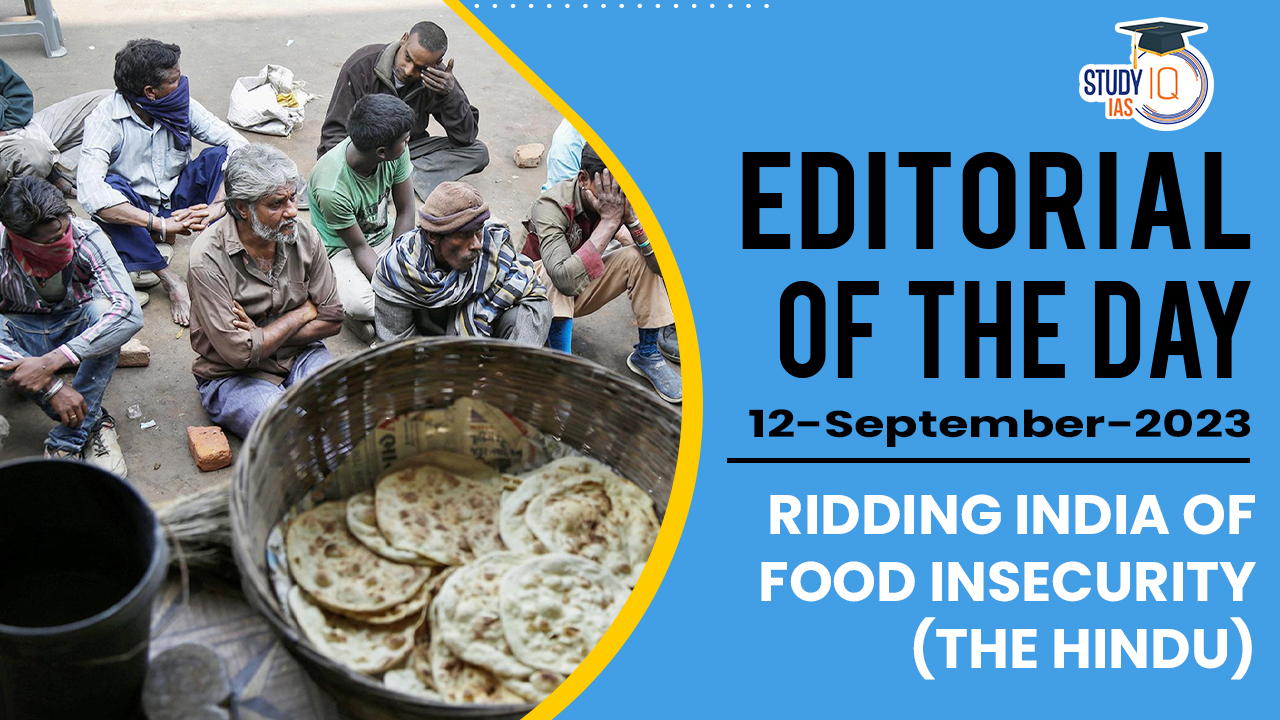Table of Contents
Context: The article is discussing the issue of food-price inflation in India and its impact on the population’s ability to afford a healthy diet. It points out that India has been experiencing rising food prices since 2019, with annual inflation exceeding 11% in July 2023, the highest in a decade, causing concern in accessing nutritious food. The article references a report from the Food and Agriculture Organization (FAO) titled ‘State of Food Security and Nutrition in the World,‘ that provides the status of food insecurity in the country. Overall, the article emphasizes that ensuring that Indians have access to a healthy diet is a critical economic policy challenge, given the high levels of food-price inflation and the large portion of the population struggling to afford nutritious food. This is significant because it relates to the well-being and nutritional health of a substantial portion of India’s population.
Background
Food security refers to the state in which all individuals in a country have access to sufficient, safe, and nutritious food to meet their dietary needs and preferences for an active and healthy life.
This involves various dimensions such as:
- Availability of food through production and imports
- Accessibility of food without any discrimination, and
- Affordability of food for everyone.
Therefore, food security is achieved only when there is adequate food available for all individuals, they have the means to purchase food of acceptable quality, and there are no barriers preventing access to food.
Read more on Food Security in India at
https://www.studyiq.com/articles/indias-hunger-paradox/
Decoding the Editorial
- The ‘State of Food Security and Nutrition in the World’ report by FAO which estimates that in 2021, a staggering 74% of the Indian population cannot afford a healthy diet.
- With India’s large population, this means that approximately one billion Indians may not have the financial means to access nutritious food.
Affordability of a Healthy Diet:
The article is discussing why the finding that over half of India’s population cannot afford a healthy diet, as reported by the Food and Agriculture Organization (FAO), is plausible. It provides several pieces of evidence to support this plausibility:
- Price of Food in Mumbai:
- A study conducted in Mumbai from 2018 to 2023 found that the cost of preparing a typical meal (thaali) at home has increased by 65%.
- During the same period, the average wages of manual workers increased by only 38%, and salaried workers saw a 28% increase in their wages.
- This suggests that the rising cost of food has outpaced the growth in wages, leading to a reduction in the purchasing power of the population.
- Prevalence of Anaemia:
- As per the National Family Health Survey conducted from 2019 to 2021, a rise in the prevalence of anaemia, primarily caused by nutrient deficiency.
- The survey found that over 50% of adult women in India were estimated to be anaemic, indicating that many are not getting the necessary nutrients in their diets.
- FAO’s Finding:
- Given the above evidence, the article argues that the FAO’s finding that over half of India’s population cannot afford a healthy diet is plausible.
- Even if one were to assume that the FAO has overestimated the numbers by 100%, there would still be 500 million people in this category, which is a significant and concerning figure.
- Ineffective Macroeconomic policies:
- The article also criticizes the effectiveness of macroeconomic policies, particularly the Reserve Bank of India’s approach to controlling inflation through measures like “inflation targeting.”
- It argues that such policies are ineffective in addressing food inflation, which is largely driven by supply-side factors.
- Instead, the article suggests that interventions on the supply side, such as increasing agricultural yields, are necessary to ensure that food is produced and sold at more stable prices, making it more affordable for the population.
Significance of Green Revolution:
- Historical Significance of the Green Revolution:
- India has a rich history of the Green Revolution, which took place in the 1960s.
- During this period, India faced severe food shortages due to successive droughts.
- In response, the government implemented a supply-side strategy that included providing farmers with high-yielding seeds, affordable credit, and guaranteed prices for their produce through procurement.
- This strategy was highly successful and transformed India from a food-dependent nation to a self-sufficient one.
- Comparison with Other Achievements:
- It suggests that the success of the Green Revolution in India, given the country’s extreme poverty and the challenge of feeding a massive population, might be even more remarkable when compared to other achievements, such as the United States’ mission to land a human on the moon.
- Recognizing Past Mistakes:
- The article acknowledges that there were mistakes made during the Green Revolution, such as over-reliance on chemical fertilisers, which degraded soil quality, and a focus on procurement prices rather than productivity increase, which contributed to inflation.
- However, it argues that instead of dwelling on these mistakes, the focus should be on rectifying them and learning from them.
- Need for a Second Agricultural Revolution:
- The article argues that India now needs a second agricultural revolution to address current challenges in the agriculture sector.
- It emphasizes that the primary goal of this revolution should be to lower the cost of producing food, unlike the first Green Revolution, which focused mainly on achieving self-sufficiency.
- Lowering production costs is seen as essential to combat rising food prices.
- Key Areas for Improvement: The article outlines several areas where action is needed in the agricultural sector, including extending irrigation coverage to all arable land, removing restrictions on land leasing, investing in agricultural research, and improving extension services to support farmers.
Initiatives to work on:
The article outlines several key initiatives that need to be undertaken to address challenges in India’s agriculture sector and ensure access to a healthy diet for all its citizens.
- Expanding on Proposals:
- These proposals include increasing public expenditure on irrigation, addressing land fragmentation through leasing, revitalizing public agricultural research institutes, and reviving agricultural extension services.
- The goal of these initiatives is to boost agricultural productivity and protein production.
- Challenges with Irrigation:
- The article acknowledges that despite increased public expenditure on irrigation, there hasn’t been a corresponding increase in the irrigated area.
- It raises questions about the efficiency of resource utilization and the possibility of funds being misallocated or wasted in the irrigation sector.
- Importance of Land Leasing: It highlights the importance of land leasing as a solution to the problem of fragmented land holdings. Allowing farmers to lease land can facilitate larger and more productive agricultural operations.
- Revitalizing Research Institutes: There is a need to re-energize India’s public agricultural research institutes, which played a vital role in the success of the first Green Revolution in the 1960s. These institutes need to be more proactive in developing and disseminating innovative agricultural practices.
- Reviving Extension Services: It notes that agricultural extension services have dwindled over time, and there’s a need to bring them back to their former prominence. Extension workers, like the gram sevak, played a crucial role in educating farmers about best agricultural practices.
- Role of States: There is a crucial role of individual states in implementing these initiatives. It suggests that a collaborative approach between the central government and state governments is essential, working together in the spirit of cooperative federalism.
- States should actively participate in efforts to enhance agricultural productivity rather than relying solely on central food allocations for their Public Distribution System.
- Non-Ideological Approach: There is a need for a non-ideological approach, both at the central and state levels, when addressing agricultural challenges.
- It points out that in the past, even leaders with different ideologies were willing to adopt strategies like the Green Revolution because of their potential to improve food security and reduce poverty.
- It suggests that ecological considerations should also be included in the approach to ensure sustainability.


 Micrometeoroids: Tiny Space Particles, M...
Micrometeoroids: Tiny Space Particles, M...
 India Needs a National Insolvency Tribun...
India Needs a National Insolvency Tribun...
 Unlocking the Potential of India–Afric...
Unlocking the Potential of India–Afric...

























